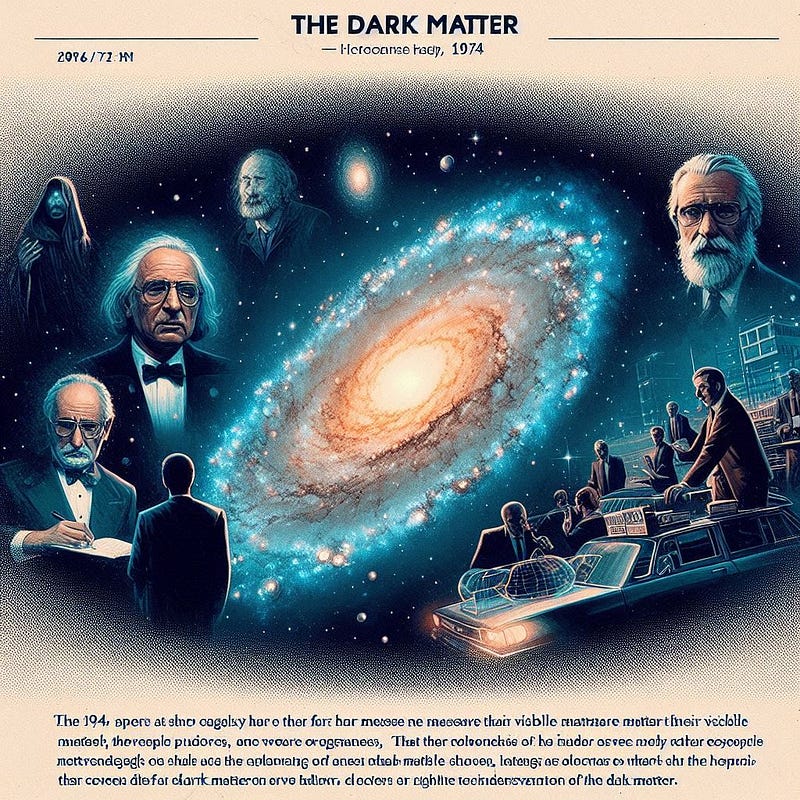The Enigmatic Nature of Dark Matter: Unveiling Cosmic Secrets
Written on
Chapter 1: The Discovery of Dark Matter
In 1974, pivotal research transformed our comprehension of the cosmos. These groundbreaking papers revealed that galaxies possess far greater mass than what is visible, leading to the hypothesis of unseen matter. This seminal work effectively unveiled what we now refer to as dark matter, a concept that continues to influence our understanding of the universe.

Dark matter plays a crucial role in explaining the structure and evolution of the universe. However, its precise nature remains elusive, despite extensive research efforts. In the 1970s, scientists utilized supercomputers to conduct the first simulations of galaxy clustering. These simulations demonstrated that a uniform distribution of mass would become uneven due to gravitational forces. The results indicated that galaxies would be unstable and disintegrate rapidly. To account for the observed stability of galaxies like the Milky Way, researchers proposed the existence of a massive, invisible ‘halo’ enveloping the visible disk. This halo would supply the necessary gravitational pull to maintain the galaxy's integrity. Nevertheless, this idea faced skepticism as many questioned its universal applicability and the possibility of alternative stabilizing factors.

The concept of dark matter was initially met with doubt. However, cosmologists examining the universe's mass distribution became intrigued by the notion of substantial galactic halos. They observed that galaxy clusters did not exhibit distinct spatial boundaries and speculated that the same might apply to individual galaxies. Through dynamic measurements of galaxy masses, they discovered that mass measurements taken farther from the center indicated a higher total mass, extending beyond the visible galaxy. This led to the conclusion that galaxies lack clear boundaries and are enveloped by massive, unseen halos, possibly composed of faint stars. This revelation substantially increased the estimated mass of the universe, suggesting it might indeed be closed.

Meanwhile, esteemed Soviet physicists made significant contributions to the field of cosmology. They assembled a team of skilled physicists to accurately model galaxies based on known stellar populations and their distributions. However, they faced difficulties while attempting to model the Andromeda galaxy, as the observed rotation of hydrogen clouds at the galaxy's edges could not be reconciled with the existing stellar population. This conundrum remained unresolved for a period.
Later discussions suggested that galaxies might extend beyond their visible disks and be enveloped by an unseen mass, termed the “galactic corona.” Although the idea was presented at a conference, it received a lukewarm reception. To bolster their claims, cosmologists sought additional evidence. They uncovered the “Zwicky problem” and x-ray studies that supported the presence of unseen mass in galaxies, hypothesizing that this mass could represent a new population of stars.
Despite facing challenges, including censorship, their findings were eventually published in a Nature paper, asserting that galaxies are surrounded by substantial, invisible coronae. This increased the estimated mass of the universe tenfold and indicated that dark matter constitutes the majority of the universe's matter. Another paper independently provided evidence for dark matter by synthesizing arguments across various scales. Although some astronomers initially disputed the data and methodologies employed, the perseverance of these researchers exemplified the emerging field of physical cosmology, which thrived on interdisciplinary collaboration.
The concept of dark matter gradually gained traction in the late 1970s, propelled by conferences and lectures that shifted perceptions from skepticism to acceptance within a few short years. Further validation came from new observations of galaxy rotation and theoretical advancements linking dark matter to galaxy formation and neutrinos. By the decade's end, dark matter was widely recognized as a fundamental aspect of the universe, marking a significant breakthrough in modern astronomy.
The quest for dark matter remains at the forefront of contemporary physics. Recent initiatives have included ambitious experiments aimed at understanding the properties of weakly interacting massive particles (WIMPs), a leading candidate for dark matter. Additionally, researchers are investigating innovative methods to detect “thermalized” dark matter trapped within the gravitational field of Earth. Other studies are exploring potential correlations between dark matter and supermassive black holes, as well as examining evidence in the behaviors of pulsars and galaxy clusters. These ongoing inquiries reflect our commitment to advancing scientific exploration and discovery.

In this video, Brian Cox discusses the mysteries surrounding dark matter and the implications of NASA's findings about the universe.
This presentation delves into the concept that the universe may be concealing vital information from us, as explored by ESA's Euclid mission.
References
- Einasto, A. Kaasik, E. Saar, Nature 250, 309 (1974); “Dynamical evidence of massive coronas of galaxies.”
- Ostriker, J.P., Peebles, P.J., and Yahil, A., 1974. The size and mass of galaxies, and the mass of the universe. Astrophysical Journal, vol. 193, Oct. 1, 1974, pt. 2, p. L1-L4.